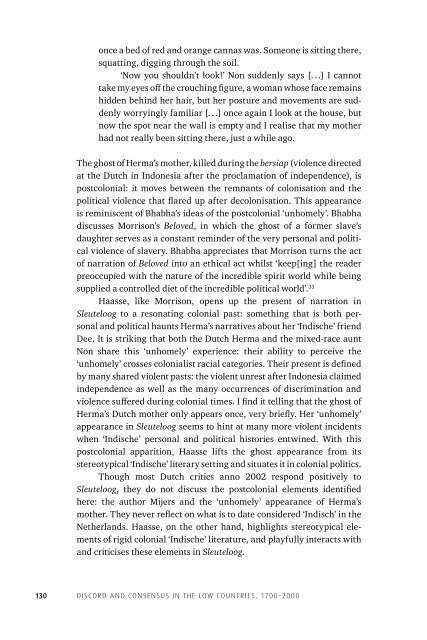Discord Consensus
7aze300jFJo
7aze300jFJo
Create successful ePaper yourself
Turn your PDF publications into a flip-book with our unique Google optimized e-Paper software.
once a bed of red and orange cannas was. Someone is sitting there,<br />
squatting, digging through the soil.<br />
‘Now you shouldn’t look!’ Non suddenly says [. . .] I cannot<br />
take my eyes off the crouching figure, a woman whose face remains<br />
hidden behind her hair, but her posture and movements are suddenly<br />
worryingly familiar [. . .] once again I look at the house, but<br />
now the spot near the wall is empty and I realise that my mother<br />
had not really been sitting there, just a while ago.<br />
The ghost of Herma’s mother, killed during the bersiap (violence directed<br />
at the Dutch in Indonesia after the proclamation of independence), is<br />
postcolonial: it moves between the remnants of colonisation and the<br />
political violence that flared up after decolonisation. This appearance<br />
is reminiscent of Bhabha’s ideas of the postcolonial ‘unhomely’. Bhabha<br />
discusses Morrison’s Beloved, in which the ghost of a former slave’s<br />
daughter serves as a constant reminder of the very personal and political<br />
violence of slavery. Bhabha appreciates that Morrison turns the act<br />
of narration of Beloved into an ethical act whilst ‘keep[ing] the reader<br />
preoccupied with the nature of the incredible spirit world while being<br />
supplied a controlled diet of the incredible political world’. 33<br />
Haasse, like Morrison, opens up the present of narration in<br />
Sleuteloog to a resonating colonial past: something that is both personal<br />
and political haunts Herma’s narratives about her ‘Indische’ friend<br />
Dee. It is striking that both the Dutch Herma and the mixed-race aunt<br />
Non share this ‘unhomely’ experience: their ability to perceive the<br />
‘unhome ly’ crosses colonialist racial categories. Their present is defined<br />
by many shared violent pasts: the violent unrest after Indonesia claimed<br />
independence as well as the many occurrences of discrimination and<br />
violence suffered during colonial times. I find it telling that the ghost of<br />
Herma’s Dutch mother only appears once, very briefly. Her ‘unhomely’<br />
appearance in Sleuteloog seems to hint at many more violent incidents<br />
when ‘Indische’ personal and political histories entwined. With this<br />
postcolonial apparition, Haasse lifts the ghost appearance from its<br />
stereo typical ‘Indische’ literary setting and situates it in colonial politics.<br />
Though most Dutch critics anno 2002 respond positively to<br />
Sleuteloog, they do not discuss the postcolonial elements identified<br />
here: the author Mijers and the ‘unhomely’ appearance of Herma’s<br />
mother. They never reflect on what is to date considered ‘Indisch’ in the<br />
Netherlands. Haasse, on the other hand, highlights stereotypical elements<br />
of rigid colonial ‘Indische’ literature, and playfully interacts with<br />
and criticises these elements in Sleuteloog.<br />
130<br />
DISCORD AND CONSENSUS IN THE LOW COUNTRIES, 1700–2000


